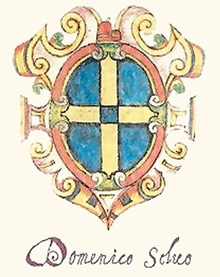Domenico Selvo
| Domenico Selvo | |
|---|---|
| Doge of Venice | |

Seal of Domenico Selvo
|
|
| Reign | 1071–1084 |
| Predecessor | Domenico I Contarini |
| Successor | Vitale Faliero |
| Born | Unknown |
| Died | 1087 |
| Wife | |
Domenico Selvo (died 1087) was the 31st Doge of Venice, serving from 1071 to 1084. During his reign as Doge, his domestic policies, the alliances that he forged, and the battles that the Venetian military won and lost laid the foundations for much of the subsequent foreign and domestic policy of the Republic of Venice. He avoided confrontations with the Byzantine Empire, the Holy Roman Empire, and the Roman Catholic Church at a time in European history when conflict threatened to upset the balance of power. At the same time, he forged new agreements with the major nations that would set up a long period of prosperity for the Republic of Venice. Through his military alliance with the Byzantine Empire, Emperor Alexios I Komnenos awarded Venice economic favors with the declaration of a Golden Bull that would allow for the development of the republic's international trade over the next few centuries.
Within the city itself, he supervised a longer period of the construction of the modern St Mark's Basilica than any other Doge. The basilica's complex architecture and expensive decorations stand as a testament to the prosperity of Venetian traders during this period. The essentially democratic way in which he not only was elected but also removed from power was part of an important transition of Venetian political philosophy. The overthrow of his rule in 1084 was one of many forced abdications in the early history of the republic that further blurred the lines between the powers of the Doge, the common electorate, and the nobility.
Beginning with the reign of Pietro II Candiano in 932, Venice saw a string of inept leaders such as Pietro III Candiano, Pietro IV Candiano, and Tribuno Memmo. The reputed arrogance and ambition of these Doges caused the deterioration of the relationship with the Holy Roman Empire in the west, the stagnancy of the relationship with the Byzantine Empire in the east, and discord at home in the Republic. However, in 991, Pietro II Orseolo became the Doge and spent his reign pushing the boundaries of the Republic further east down the western coast of the Balkan Peninsula with his conquests in Dalmatia in 1000. This strengthened the commercial bonds with the empires of the east, Sicily, Northern Africa, and the Holy Roman Empire, and put an end to the infighting among the citizens of Venice. Pietro II's negotiations with Byzantine Emperor Basil II to decrease tariffs on Venetian-produced goods helped foster a new age of prosperity in the Republic as Venetian merchants could undercut the competition in the international markets of the Byzantine Empire. Similarly, Pietro II had success developing a new relationship with Holy Roman Emperor Otto III, who displayed his friendship to him by restoring previously seized lands to Venice, opening up routes of free trade between the two states, and exempting all Venetians from taxes in the Holy Roman Empire.
...
Wikipedia
